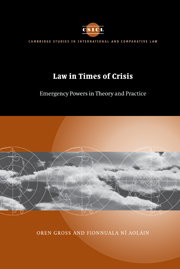Book contents
- Frontmatter
- Contents
- Acknowledgments
- Table of cases
- Table of treaties
- Table of legislation
- Table of international materials
- Introduction
- Part I
- 1 Models of accommodation
- 2 Law for all seasons
- 3 Models of extra-legality
- 4 Five degrees of separation
- Part II
- Bibliography
- Index
- CAMBRIDGE STUDIES IN INTERNATIONAL AND COMPARATIVE LAW
4 - Five degrees of separation
Published online by Cambridge University Press: 03 September 2009
- Frontmatter
- Contents
- Acknowledgments
- Table of cases
- Table of treaties
- Table of legislation
- Table of international materials
- Introduction
- Part I
- 1 Models of accommodation
- 2 Law for all seasons
- 3 Models of extra-legality
- 4 Five degrees of separation
- Part II
- Bibliography
- Index
- CAMBRIDGE STUDIES IN INTERNATIONAL AND COMPARATIVE LAW
Summary
The first three chapters examined (chapters 1 and 2) and challenged (chapter 3) the assumption of constitutionality that underlies the traditional, constitutional models of emergency regime. This chapter focuses on another fundamental assumption around which models of emergency regimes are structured, namely the assumption of separation, which is defined by the belief in our ability to separate emergencies and crises from normalcy, counter-terrorism measures from ordinary legal rules and norms. This assumption is closely linked to the different models of emergency powers as their long-term success depends on it. Success here is measured not only in the ability to overcome grave threats and dangers, but also in the ability to confine the application of extraordinary measures to extraordinary times, insulating periods of normalcy from the encroachment of vast emergency powers.
However, as we demonstrate below, bright-line distinctions between normalcy and emergency are frequently untenable. In various meaningful ways, the exception has merged with the rule, and “[e]mergency government has become the norm.”
Fashioning legal tools to respond to emergencies in the belief that the assumption of separation will serve as a firewall that protects human rights, civil liberties, and the normal legal system as a whole may be misguided. The belief in our ability to separate emergency from normalcy focuses our attention on the immediate effects of emergency measures and powers while hiding from view their long-term costs.
- Type
- Chapter
- Information
- Law in Times of CrisisEmergency Powers in Theory and Practice, pp. 171 - 244Publisher: Cambridge University PressPrint publication year: 2006



